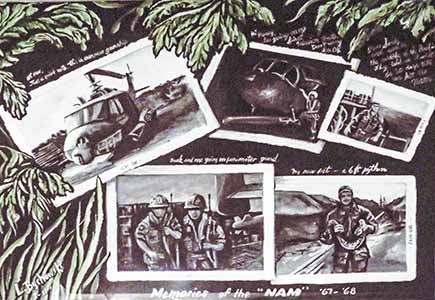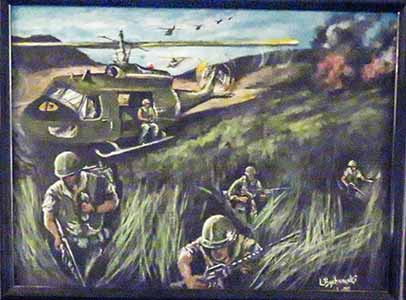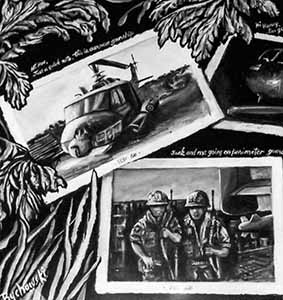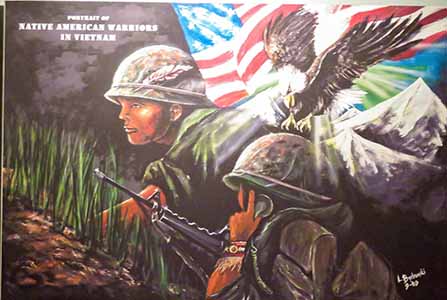Army Vietnam War Crystal Lake, IL Flight date: 09/21/22
By Carla Khan, Honor Flight Chicago Veteran Interview Volunteer
Since Larry and his twin sister were the children of a Chicago police detective, Larry was already used to discipline. When right after high school he received his draft notice, he and his cousin decided to enlist instead of being drafted. Unfortunately, the cousin backed out of the plan the very next day and Larry was stuck with a three-year commitment. His choice of service was, as he recollected with a big grin, “Do you want laundry or aviation?”
On October 11, 1965, he left for the U.S. Army Training Center at Ft. Knox, KY. where apparently the sergeants had it in for “guys from Chicago with an attitude” and had no problem literally knocking them to the ground. In retrospect, he said, the tough training physically and mentally broke him down, built him back up, and made a man out of him. He learned valuable lessons that would help him later on in life.
Having opted for aviation, Larry went to Ft. Rucker, AL for 6 weeks of Advanced Individual Training (AIT). He was going to be a crew chief with total responsibility for an aircraft doing the daily inspection and signing-off in the log book. In short, he would be responsible for the safety of the crew and the aircraft. The three kinds of planes that were used for training were: the Bird Dog (observer), the Beaver (utility), and the Otter (cargo utility). Eventually, Larry also learned to fly, but that was not till much later and at the insistence of his son.
With training completed in 1966, Larry as a part of a group of 8 crew chiefs, was sent to Ft. Lewis, about 10 miles south of Tacoma, WA. Unfortunately, this base happened to be more of a civilian air club; there were no military planes to check out and the location for their Military Occupational Status (MOS) was incorrectly assigned to them. A friendly Major promised that he’d make the correction but when they asked the next day, they learned that the Major had suddenly left for Korea. The Lt. Colonel said he’d make the correction and that in the meanwhile, he’d offer the group of 8 crew chiefs various jobs such as catering his parties, reporting directly to him. Larry remembered that he pulled KP duty 111 times and that since they reported to the Lt. Colonel, they got away with activities such as renting motorbikes and storing them in the old WWII POW barracks.
Finally, in 1967, they had to report to their main post where they noticed very unusual looking aircraft on the flightline and were told they were going to be the crew chiefs. As it turned out, these were OV-1 Mohawks, armed observations and attack planes, with the ability to execute light strikes. Another 8 weeks of training followed, this time at Ft. Rucker, AL. Special instructions included caution because the aircraft carried ammo, and also because it often would be flying at tree-top height. And then, suddenly the order came to go home for 30 days of “pre-combat leave.” The making of a will was also casually included in the instructions because they’d be going to a “restricted area in S.E. Asia.” Larry said goodbye to Sandy to whom he’d been married since May 7th of that year, and to their dog (appropriately named VC); both were sent home to Chicago.
Larry was issued a driver’s license and told to drive a truck to S. Tacoma where the equipment would be loaded onto an aircraft carrier. Larry himself was flown to San Diego where he boarded, according to him, one of the oldest ships afloat, the USS General John Pope. This WWII troop transport ship carried 400 soldiers from Larry’s unit in addition to 5,000 Marines. As Larry’s unit had its own commanding officers and rules, they were not reporting to the Marine sergeants. However, one day when Larry was in his civvies, a Marine sergeant reprimanded him and made him do 30 pushups on the boiling hot deck. Larry, who in Basic Training had learned to obey first and question later, did the push-ups that caused blisters on his hands. As soon as he was done, he went to his commanding officer who immediately made sure in no uncertain terms that no Marine sergeant would ever bother any of his men again. In total, it took 30 long and hot days to cross the Pacific. There was no air-conditioning, only salt water for showers, no change of clothes, and the bunks were four levels down! Sadly enough, two men went overboard and only one of them was rescued.







The first stop was in Okinawa; when the Marines left the ship in Da Nang, they had to use rope ladders. Larry’s unit, the 245th, continued during the night through the Mekong Delta where for the first time they saw and heard explosions. They met an Army chaplain who welcomed them with the encouraging words, “half of you won’t make it home.” At Vung Tau, at the end of the long trip, the men did have a pleasant surprise when they saw the side of the ship open up. They were able to disembark by walking the gangplank rather than having to use the rope ladders like the Marines before them did.
Quick instructions were to load up 5 magazines with ammo but not to put 20 into the clip of the M-16 or it would jam; also that a C-130 would pick the men up shortly. Like in other military aircraft, there were no seats, which was ok but shortly after take-off the left engine was shot out and the pilot had to turn around, land and make sure the fire was extinguished. That was Larry’s welcome to Vietnam.
His next stop was Can Tho, also located in the Mekong Delta. He was there for 8 months. For the first 2 months, the crew chiefs acted as perimeter guards for the barbed wire fence and manned the watchtower. At one time, Larry and his very best friend, Jack, were in a convoy to pick up equipment when they were ambushed and came under fire. It was dark, they were in the jungle. Jack was at the wheel while Larry hung out of the open door firing and trying to keep the enemy at bay. Jack fell out of the truck and Larry, not about to abandon his friend, jumped out after him. Eventually, a rickshaw driver came by and because Larry had learned to speak Vietnamese, he could explain where they wanted to go. Fortunately, the driver was not a VC!
On another occasion, Larry and Jack, along with a sergeant, had to meet a barge to pick up supplies. The ship’s master told them they would be safe because his guard dog would bark if an enemy came. The dog kept barking; the ship’s master and the sergeant had had too much to drink. They all were under heavy enemy fire and had to defend themselves with their M-16s. Eventually 2 helicopters came to the rescue and chased the enemy off. It was a narrow escape.
However, the worst was yet to come because Larry, now with the 224th Aviation Company, was in the Mekong Delta during the TET Offensive. They were not welcomed by their own Army’s Engineering Company “because your unit has Mohawks and the VC wants those planes.” They lived in tents with wooden floors, and the rats were huge. Larry remembered that many of the little kids had scars from rat-bites on their faces and hands. In spite of the hardship, the Crew Masters completed their daily inspections and repairs such as making sure that the seats each had 1/4th stick of TNT for ejection. The planes had 150-gallon fuel tanks that could be replaced by bombs. Only trained and experienced Crew Masters could exchange those tanks but unfortunately because someone else miscommunicated, one fuel tank dropped and a soldier was severely injured. On occasions when there was no observer available, a crew chief would go on patrol with the pilot. Larry made several of those trips.
During another “encounter” Larry said he was ready with the pilot next to the aircraft when a mortar came in. Larry, never having seen so many explosions and so much fire at the same time exclaimed, “Hey, that’s just like the start of the Jackie Gleason Show” when the horrified pilot grabbed him to get cover while yelling – expletive deleted.
Stationed at the so-called Marble Mountain Air Facility, Larry worked the 6 PM – 6 AM shift because as he put it, “enemy fire happened always during the night anyway.” One night, when he and his crew were on their way to the mess hall and had left their helmets, weapons and ammo in the maintenance building, a helicopter filled with ammo was hit and exploded. Larry and the others jumped into a sewer ditch filled with raw sewage and were also immediately covered with biting red ants. As he mentioned before, they were trained as crew chiefs and not for combat. But during the grueling TET offensive, they all equally and desperately fought for their own and each other’s lives. To make matters worse, communication with home had stopped. Larry and Sandy used to write to each other at least once a week and suddenly Sandy had not had any mail for as long as 40 days. She worked as a checker in a store and a “helpful” customer came in and told her that in the Da Nang area where he knew Larry was posted, there had been 80% casualties in heavy combat. Fortunately, during a lull in the fighting in early May, he managed to get a letter to her.
Finally, Larry was fewer than 90 days away from completing his tour and was allowed to head towards home. He flew in a Mohawk to Cam Ranh Bay where soldiers were called up in alphabetical order to board a Continental Airlines plane that would fly them to Ft. Lewis. Larry’s next stop was O’Hare Airport in Chicago. He was home again!
Sandy, in the meanwhile, had purchased a house in Carpentersville which is where they settled for the next 25 years and raised their 3 children. For Larry, the experience had not ended yet. During his service, he’d inhaled poisonous fumes that diseased his liver. Immediately following his discharge, he was admitted to the nearest military hospital.
His one month hospital stay turned out to be the beginning of a very happy ending. Because he liked to draw, he was encouraged to take a VA mail-in art course which was not only how he discovered he was a very talented artist, it also led him to his profession as a technical illustrator at Sun Electric and as a graphic artist. Since his retirement, he added painting to his skill-set and has had several very successful exhibits. He paints from memory or photographs and often depicts scenes and people who made the most impression on him during his lifetime.
His dear friend, Jack, reconnected with him after 25 years and the two buddies now stay in close contact. Larry and Sally enjoy their retirement and when not painting, he visits with his children and grandchildren.
Larry, we thank you for your courageous service to our country! Enjoy your well-deserved day of honor on the 105th flight of Honor Flight Chicago!


